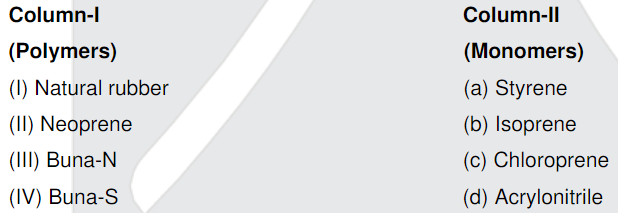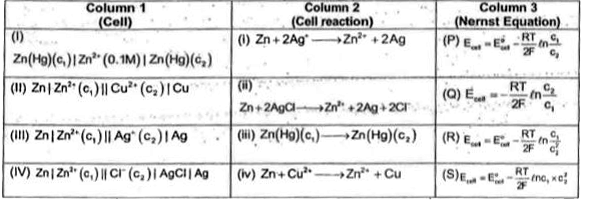Which of the following combination of species undergo(es) comproportionation?
MnO−4(aq.)+Mn2+(aq.)Zn∅ZnSO4−−−−−→
S+conc.H2SO4(excess)warm−−→
PH3+H3PO4→
NO(g)+NO2(g)cool−−→
The correct Answer is:A, B
To determine which of the given combinations of species undergo comproportionation, we need to analyze each reaction and identify the changes in oxidation states of the elements involved. Comproportionation occurs when two different oxidation states of the same element react to form a product with an intermediate oxidation state.
1. Analyze Reaction A: MnO4- + Mn2+ → MnO2 + H+
- In MnO4-, manganese is in the +7 oxidation state.
- In Mn2+, manganese is in the +2 oxidation state.
- In MnO2, manganese is in the +4 oxidation state.
- Here, manganese from two different oxidation states (+7 and +2) combines to form manganese in an intermediate oxidation state (+4).
- Conclusion: This is a comproportionation reaction.
2. Analyze Reaction B: S + H2SO4 → SO2 + H2O
- In elemental sulfur (S), the oxidation state is 0.
- In H2SO4, sulfur is in the +6 oxidation state.
- In SO2, sulfur is in the +4 oxidation state.
- Here, sulfur from two different oxidation states (0 and +6) combines to form sulfur in an intermediate oxidation state (+4).
- Conclusion: This is also a comproportionation reaction.
3. Analyze Reaction C: pH3 + H3PO4 → No Reaction
- Since there is no reaction, we cannot analyze oxidation states here.
- Conclusion: This does not undergo comproportionation.
4. Analyze Reaction D: NO + NO2 → N2O + O2
- In NO, nitrogen is in the +2 oxidation state.
- In NO2, nitrogen is in the +4 oxidation state.
- In N2O, nitrogen is in the +1 oxidation state, and O2 has an oxidation state of 0.
- Although there are changes in oxidation states, nitrogen does not combine from different oxidation states to form a product with an intermediate oxidation state. Thus, this is not a comproportionation reaction.
- Conclusion: This does not undergo comproportionation.
Final Answer:
The combinations that undergo comproportionation are:
- A (MnO4- + Mn2+)
- B (S + H2SO4)
- In MnO4-, manganese is in the +7 oxidation state.
- In Mn2+, manganese is in the +2 oxidation state.
- In MnO2, manganese is in the +4 oxidation state.
- Here, manganese from two different oxidation states (+7 and +2) combines to form manganese in an intermediate oxidation state (+4).
- Conclusion: This is a comproportionation reaction.
- In elemental sulfur (S), the oxidation state is 0.
- In H2SO4, sulfur is in the +6 oxidation state.
- In SO2, sulfur is in the +4 oxidation state.
- Here, sulfur from two different oxidation states (0 and +6) combines to form sulfur in an intermediate oxidation state (+4).
- Conclusion: This is also a comproportionation reaction.
- Since there is no reaction, we cannot analyze oxidation states here.
- Conclusion: This does not undergo comproportionation.
- In NO, nitrogen is in the +2 oxidation state.
- In NO2, nitrogen is in the +4 oxidation state.
- In N2O, nitrogen is in the +1 oxidation state, and O2 has an oxidation state of 0.
- Although there are changes in oxidation states, nitrogen does not combine from different oxidation states to form a product with an intermediate oxidation state. Thus, this is not a comproportionation reaction.
- Conclusion: This does not undergo comproportionation.
The combinations that undergo comproportionation are:
- A (MnO4- + Mn2+)
- B (S + H2SO4)
Topper's Solved these Questions
- TYPES OF REACTIONSBOOK - VK JAISWAL ENGLISHCHAPTER - TYPES OF REACTIONSEXERCISE - MATCH THE COLUMN
14 Videos
- TYPES OF REACTIONSBOOK - VK JAISWAL ENGLISHCHAPTER - TYPES OF REACTIONSEXERCISE - SUBJECTIVE PROBLEMS
42 Videos
- TYPES OF REACTIONSBOOK - VK JAISWAL ENGLISHCHAPTER - TYPES OF REACTIONSEXERCISE - LEVEL 3
44 Videos
- s-BLOCK ELEMENTSBOOK - VK JAISWAL ENGLISHCHAPTER - s-BLOCK ELEMENTSEXERCISE - SUBJECTIVE PROBLEMS
2 Videos
Similar Questions

Which of the following combination is correct:
View Solution
Which of the following combination is correct:
View Solution

Which of the following combination is correct ?
View Solution
Which of the following combination is correct?
View Solution
Which of the following combination is correct?
View SolutionWhich of the following combination of species can evolve O2?
View SolutionWhich of the following combination of species can evolve O2?
View SolutionWhich of the following combinations is correct ?
View Solution
Which of the following combination is CORRECT ?
View SolutionWhich of the following combinations is correct?
View Solution
